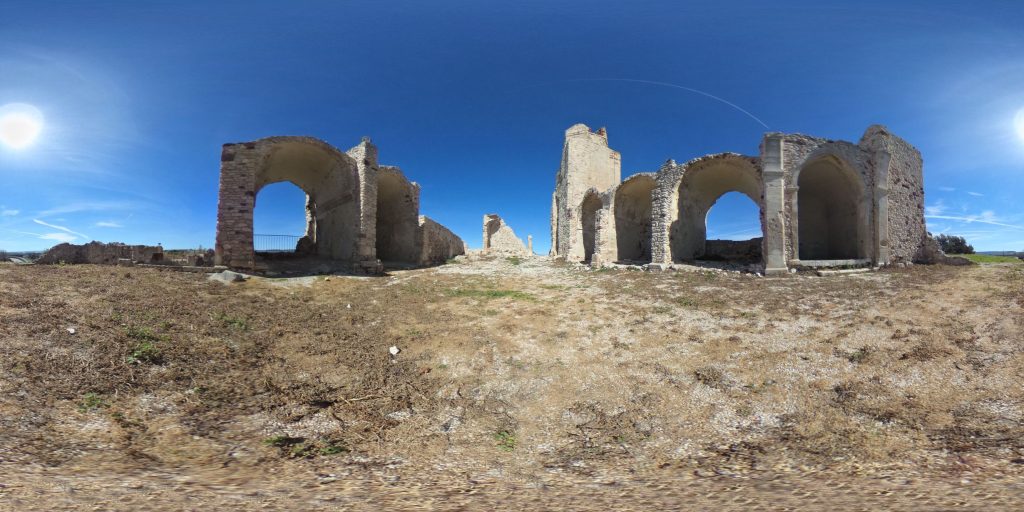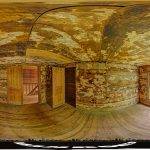Discovering the Forgotten Majesty: Doria Castle in Chiaramonti
Discover the haunting beauty of Doria Castle in Chiaramonti, Italy, through a 360-degree panoramic view that captures its enigmatic charm. Urban explorers will be captivated by the stunning images available on Google Maps Street View, offering a virtual tour of this abandoned fortress. Immerse yourself in the historical allure and eerie atmosphere of Doria Castle, a perfect destination for those who seek adventure and mystery in forgotten places.
Nestled in the picturesque hills of the Province of Sassari, Italy, the Doria Castle in Chiaramonti stands as a testament to the passage of time. Its stone walls, now weathered and overgrown with ivy, echo tales of medieval grandeur and power. This abandoned castle, though neglected, holds immense historical significance and continues to captivate the imaginations of history buffs and urban explorers alike. Join us on a journey through the past, present, and potential future of the enigmatic Doria Castle.
The Birth of Doria Castle: A Medieval Stronghold
The Doria Castle, also known as Castello dei Doria, was constructed in the 13th century, around 1272. It was built by the Doria family, a prominent Genoese family known for their maritime prowess and political influence. The Doria family played a significant role in the medieval history of the Mediterranean, establishing various fortresses and castles to assert their control and protect their territories.
Chiaramonti, a small village in northern Sardinia, was strategically chosen for the castle’s location. Perched on a hilltop, the castle offered a commanding view of the surrounding countryside, making it an ideal spot for both defense and oversight of the region. The Doria Castle was not just a military fortress but also served as a residence for the Doria family and their retainers, symbolizing their dominance and prestige.
Historical Significance: Power, Conflict, and Decline
The Doria Castle was more than just a residence; it was a hub of power and influence. During its prime, the castle was involved in various regional conflicts and power struggles. The Doria family used it as a base to exert control over Sardinia, which was a contested territory between various feudal lords, the Aragonese, and later the Spanish.
Throughout the 14th and 15th centuries, the castle witnessed numerous battles and sieges. The most notable conflict was the struggle between the Doria family and the Aragonese crown, which sought to consolidate its control over Sardinia. Despite several attempts by the Aragonese to capture the castle, the formidable defenses of Doria Castle allowed it to withstand multiple sieges, bolstering the Doria family’s reputation as formidable defenders of their stronghold.
However, the tides of power shifted in the late 15th century. With the increasing dominance of the Spanish crown over Sardinia, the strategic importance of the Doria Castle began to wane. By the early 16th century, the castle’s role as a military fortress had diminished, and it gradually fell into disuse. The Doria family, facing political and economic challenges, could no longer maintain the castle, leading to its abandonment.
Abandonment and Decay: A Silent Witness to History
The decline of the Doria Castle was a slow and inevitable process. As the Doria family’s influence diminished and Sardinia came under more stable control, the need for such a fortress lessened. The castle was left to the mercy of the elements and the passage of time.
Over the centuries, the once-mighty walls of the Doria Castle have crumbled, and nature has reclaimed much of the structure. Ivy and other vegetation now cloak the ruins, adding to its haunting beauty. The castle’s interiors, once bustling with the activities of the Doria household, are now silent and empty, save for the occasional visitor who ventures to explore its forgotten halls.
The Allure of Abandonment: A Haven for Urban Explorers
Despite its state of decay, or perhaps because of it, the Doria Castle has become a magnet for urban explorers and history enthusiasts. The allure of abandoned places lies in their ability to evoke a sense of mystery and wonder, and the Doria Castle is no exception. Walking through its ruins, one can almost hear the echoes of the past—whispers of medieval lords, the clash of swords, and the hum of daily life within the castle walls.
For urban explorers, the Doria Castle offers a unique opportunity to step back in time and experience a piece of history firsthand. The crumbling walls, overgrown courtyards, and hidden chambers provide a tantalizing glimpse into a world long gone. The castle’s remote location adds to the sense of adventure, making it a coveted destination for those who seek to uncover the stories etched into its stones.
The Future of Doria Castle: Preservation and Possibilities
The future of the Doria Castle remains uncertain. While there have been some efforts to preserve and restore the castle, challenges such as funding, environmental factors, and the sheer scale of the project have hindered progress. The local community and heritage organizations recognize the historical value of the castle and are working towards finding sustainable solutions to protect this cultural landmark.
One potential avenue for the future of Doria Castle is its integration into tourism initiatives. Sardinia’s rich history and stunning landscapes make it a popular destination for travelers. By promoting the castle as a historical and cultural attraction, it could attract visitors and generate the necessary funds for its preservation. Guided tours, historical reenactments, and events could bring the castle to life, offering visitors a deeper understanding of its significance and an immersive experience of medieval Sardinia.
Moreover, the castle’s inclusion in digital projects, such as 360-degree panoramic images and virtual tours, can help raise awareness and appreciation for this historical site. Such initiatives not only make the castle accessible to a global audience but also highlight the importance of preserving our shared heritage.
Exploring Doria Castle: A Journey Through Time
For those who are passionate about history and urban exploration, visiting the Doria Castle is an unforgettable experience. As you wander through the ruins, each step brings you closer to the lives and stories of those who once called this place home. The castle’s architecture, though worn by time, still speaks of its former grandeur and the ingenuity of its builders.
The Doria Castle’s strategic hilltop location offers breathtaking views of the surrounding countryside, providing a sense of why this site was chosen for such an important stronghold. The panoramic vistas from the castle’s towers and walls give visitors a glimpse into the past, when these same views were watched over by the vigilant eyes of medieval guards.
Practical Information for Visitors
If you’re planning a visit to the Doria Castle, here are some practical tips to ensure a memorable and safe exploration:
- Access: The castle is located near the village of Chiaramonti in the Province of Sassari. While the site is accessible by car, the final approach involves a short hike up the hill where the castle stands.
- Best Time to Visit: The best time to visit is during the spring and autumn months when the weather is mild, and the surrounding landscape is particularly beautiful.
- Safety: As an abandoned site, the castle can be hazardous. Be cautious of unstable structures, loose stones, and overgrown areas. It’s advisable to wear sturdy footwear and bring a flashlight for exploring darker areas.
- Guided Tours: Consider joining a guided tour if available. Local guides can provide valuable insights into the castle’s history and architecture, enriching your visit.
- Respect the Site: As with all historical sites, it’s important to respect the Doria Castle. Avoid removing any artifacts, graffiti, or causing damage to the structure.
Conclusion: The Enduring Legacy of Doria Castle
The Doria Castle in Chiaramonti stands as a silent witness to centuries of history, a monument to the power and ambition of the Doria family, and a symbol of the ever-changing tides of time. Though abandoned and left to decay, its ruins continue to inspire awe and curiosity, drawing visitors into a forgotten world of medieval intrigue and grandeur.
As we look to the future, the preservation of the Doria Castle becomes a shared responsibility. Through collective efforts, we can ensure that this remarkable piece of history remains a source of inspiration and education for generations to come. Whether through physical restoration or digital preservation, the story of the Doria Castle will endure, reminding us of the rich tapestry of human history and the enduring allure of the past.
If you liked this blog post, you might be interested in reading about the Slains Castle in the United Kingdom, the Ha Ha Tonka Castle Ruins in Missouri or the Koknese Castle in Latvia.

A 360-degree panoramic image captured at the abandoned Doria Castle in Sardinia, Italy. Image by: Paolo Codini
Do you have 360-degree panoramic images captured in an abandoned location? Send your images to Abandonedin360@gmail.com. If you choose to go out and do some urban exploring in your town, here are some safety tips before you head out on your Urbex adventure.
Unlock the secrets of exploration by diving into precise GPS data available exclusively for an array of hidden gems and hundreds of other captivating sites, all within our members’ section. By investing in a Gold Membership, you’re not just gaining access; you’re securing a key to a vast, global archive of abandoned, untouched, and mysterious locations waiting to be discovered. Embark on your adventure with confidence, knowing every corner of the world can be within your reach. Don’t just observe—explore, discover, and claim the extraordinary journey that lies ahead with our treasure trove of world secrets. Subscribe now and transform the way you see the world!
If you want to start shooting 360-degree panoramic images, you might want to look onto one-click 360-degree action cameras.
Click on a state below and explore the top abandoned places for urban exploring in that state.






